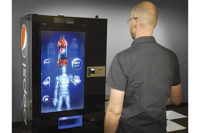KeVita builds the next generation of health and wellness beverages
KeVita reveals a new brand extension coming this fall



The opening of KeVita’s new headquarters in Ventura County, Calif., more than tripled its production capacity. (Photo by Wade Hammond)


This fall, the company’s first brand extension, KeVita Master Brew Kombucha, will hit retail shelves. (Photo by Wade Hammond)





Within the beverage industry, one trend exists that generally spans every category: health and wellness. Carbonated soft drinks are experiencing it in the form of natural sweetening systems; beer and spirits have acknowledged it by offering low-calorie options; and dairy drinks have addressed it by reducing their fat content. However, consumers now are entering the “next generation” of health and wellness, and KeVita Inc. is primed to deliver.
Ten years ago, consumers defined healthy as fat-free, low-sugar and low-calorie foods and beverages, notes Bill Lange, vice president of marketing for the Ventura County, Calif.-based company. “Those were the first-generation definitions of healthy,” he says. “It’s evolved over the last few years into the second generation of healthy, which is organic, non-GMO, vegan, gluten-free, and other buzz words that used to only appear on the products sold in natural retailers, but today’s consumers are expecting to find them on almost anything they purchase.”
Looking ahead, consumers increasingly want a beverage that tastes great with all of these healthy attributes but that also offers a healthy function, Lange adds. “That is why at KeVita, we are already on to the next generation of healthy: probiotics,” he says.
Getting ahead of the curve, KeVita began producing its “next-generation” Sparkling Probiotic Drinks in 2010. The line of beverages each offer “first-generation” benefits such as an average of fewer than 15 calories and 2 grams of sugar per serving. Additionally, they are certified organic by the U.S. Department of Agriculture; free from GMOs, gluten and dairy; and vegan. Plus, they all feature four strains of live probiotics, which deliver digestive health, immune health and vitality benefits by boosting the good bacteria in the digestive tract.
“The proper balance of good bacteria in your gut allows the body to optimize the benefits of all of the food and beverages that we consume, so really probiotics are at the core of overall health and wellness,” notes KeVita Co-founder and Chief Executive Officer Bill Moses.
All of these claims and functions come packaged with a sparkling, flavorful liquid in 15.2-ounce glass bottles.
Moses adds that the company’s mission is to empower families to take their health and well-being into their own hands by providing healthy, innovative, functional beverages to help reduce the obesity epidemic in America.
From niche to mainstream
The company’s KeVita Sparkling Probiotic Drinks lineup currently consists of 12 different flavors, three of which made their debut earlier this year. Like the rest of the lineup, Blueberry Cherry, Tangerine and Hibiscus Berry initially launched exclusively in Whole Foods Market stores before making their national debut. The new flavors became available nationwide in June.
Typically, consumers in the natural channel are early adopters, which has served KeVita Sparkling Probiotic Drinks well. In particular, these consumers tend to be more familiar with the functional health-and-wellness benefits of probiotics, Lange says. As a result, he notes that half of the company’s business comes from the natural channel.
Four years after its launch, KeVita’s success in the natural channel still is visible. The brand grew nearly 100 percent in dollar sales and 115 percent in unit sales during the 24 weeks ending May 18, compared with the overall category of functional juice drinks and kombuchas, which grew 17 percent in dollar sales and 15 percent in unit sales, according to data from SPINS, Schaumburg, Ill.
However, for the first time in its history, KeVita sales in mainstream retail channels are rivaling its natural channel sales. KeVita announced its expansion into the refrigerated drinks section of the produce department in 1,400 Safeway supermarkets at the end of 2012. During the 24 weeks ending May 18, 2014, the brand increased 114 percent in both dollar and unit sales at conventional retailers, compared with approximately
13 percent dollar sales and 14 percent unit sales growth for the category, according to SPINS data.
Moses notes that one of the company’s greatest successes has been getting its products into Safeway stores for national distribution.
“What we’re seeing is that, in the conventional marketplace as it relates to Safeway, we’ve been pulled into the produce section, set alongside other juices, and have shown great adoption by the conventional buyer with continued growth,” he says. “That was really a validator for us — that, in fact, the KeVita brand is moving mainstream, and there’s a lot of mainstream acceptance.”
The company recently hit another milestone by signing a distribution agreement with Purchase, N.Y.-based PepsiCo Inc.’s Naked brand, which will incorporate KeVita Sparkling Probiotic Drinks into its chilled direct-store-distribution (DSD) system in key geographies.
“It’s really valuable that we can distribute without having to go through a lot of refrigerated DSD partners, which is a challenging matrix in the beverage world,” Moses explains. “There’s not a lot of chilled DSD out there, so to be able to partner with PepsiCo’s chilled DSD through the Naked distribution system is really a great opportunity and perfect fit for KeVita’s ambitious growth objectives.”
Currently, KeVita has joined PepsiCo’s Tropicana trucks in New York City and Naked’s DSD trucks in several other cities with national distribution in the works.
Moses attributes much of the brand’s mainstream success to its taste profile, functional benefits and health properties.
“The fact that we are full of flavor, use the highest-quality organic ingredients, and are sparkling yet are also low-calorie with no sugar added really provides a unique form of refreshment that consumers can’t find in other options right now,” he says. “It’s really in that sweet spot of the ultimate sort of refreshment that’s delicious, full of flavor, yet not water and not juice, so it really threads the needle. I think that’s a big part of it, but then when you add the benefits of probiotics on top of it, a lot of people are much more willing to try the brand.”
Additionally, the brand’s mainstream appeal is partially due to the general public’s awareness of probiotics, which has increased from 15 percent to 85 percent of the American population in less than a decade, Lange notes, citing industry statistics. It’s also attributable to the overall probiotics industry, which is a $25 billion category that is growing double digits, he adds. Much of this category is made up of supplements, which typically are purchased by consumers older than 50 years of age. This presents a whole new potential consumer base for KeVita, he points out. Currently, KeVita’s target consumers are men and women in their early 30s, skewing more female, he notes.
“The core audience for KeVita seems to be in their 30s and 40s, but we’ve also found a whole other group that’s using probiotic supplements right now that could be a market for us in the future,” Lange says. “I think as we see probiotics become more and more prevalent, you’ll see it open the doors to all age groups.”
A kick of flavor
Additionally, the trend toward beverages with a stronger bite is boosting KeVita sales. Spicy cayenne and ginger flavors are particularly on trend right now, Moses notes. As a result, KeVita Lemon Cayenne is the most popular flavor in the Sparkling Probiotic Drinks lineup, followed by Lemon Ginger.
Cleansing ingredients also are popular within the natural channel, which is creating increased interest in kale, lemon and cayenne ingredients, Moses notes. Therefore, KeVita will soon replace its Living Greens beverage with an Apple Kale variety.
“We formulated, we tested, and we found that consumers were much more interested in our new greens presentation,” Moses explains. “Kale is really on trend, and apples are really a great sweetener and still low caloric.”
In the spirit of innovation, the company is constantly looking to replace other lower-performing KeVita Sparkling Probiotic Drink SKUs with trendier varieties while still maintaining a core line of 12 SKUs. For instance, the company plans to add a Pineapple Coconut variety in the near future to bring on-trend tropical flavors into the lineup, Moses says.
Considering these trends and moves into the mainstream, Moses says he expects KeVita to be up triple digits in each of the next three years. To accommodate this growth, the company moved its headquarters to Ventura County, Calif., in November.
The new 20,000-square-foot certified-organic facility hosts KeVita’s corporate offices, R&D lab, production space and refrigerated storage. Bottling is handled by three co-packers in different parts of the country.
With employees on a single shift in the new facility, the company’s production capacity has increased 350 percent, Moses notes. Operating a double shift increases the capacity 700 percent, enabling it to produce approximately 1 million cases a month, he adds. Currently, the facility runs one shift and produces 400,000 cases a month, which demonstrates that the production line has room to grow.
“It’ll fuel us for the foreseeable future,” Moses says.
Already, this added capacity has come in handy as KeVita prepares to launch its newest line: kombuchas.
The next frontier
This fall, the company will release KeVita Master Brew Kombucha in six flavors: Ginger, Grapefruit, Pineapple Peach, Tart Cherry, Raspberry Lemon and Lavender Melon. These beverages will offer the same health benefits as the company’s flagship KeVita Sparkling Probiotic Drinks but with a different probiotic culture and flavor profile, Moses notes. In particular, the drinks will feature a bolder flavor profile that is unique to kombucha, he explains.
“We were noticing that, while clearly KeVita has a much broader consumer-friendly flavor profile, there is this kombucha drinker that really wants a much more tart, almost vinegary mouthfeel flavor,” Moses explains. “In drinking a kombucha, it’s almost a rite of passage that I’m getting something that tastes powerful, and I’m giving something of value to myself.
“We were looking at that and realizing that there is a segment out there that we were missing,” he continues. “So we decided to come up with our own kombucha so that we could complete our probiotic culture offering and really go after the bolder flavor profiles driving some consumer preference.”
However, initially there was a worry that shoppers might be confused about the difference between KeVita Sparkling Probiotic Drinks and KeVita Master Brew Kombuchas, because KeVita Sparkling Probiotic Drinks often are placed alongside kombuchas at retail, Moses notes. Over the years, the company has worked hard to educate consumers about KeVita and point out that it is not made with a kombucha culture but a non-dairy kefir culture, he says. However, after careful consideration, the team realized that adding a kombucha line should highlight the difference between the two segments.
“After looking at it and rationalizing it, we realized that this doesn’t actually create any confusion for the KeVita probiotic beverage; it actually creates a point of differentiation,” Moses says. “Now, next to KeVita on the shelf, you see KeVita Master Brew Kombucha and then KeVita’s probiotic beverage, which has a different culture and taste profile. So we took what could have been more confusing and found a way to create a brand extension that actually differentiated our lines — specifically KeVita’s probiotic beverage from the kombucha category.”
The product lines also are differ-entiated in terms of packaging. To match the kombuchas’ bolder taste profile, the company designed bolder packaging featuring amber glass bottles with handcrafted labels and less emphasis on the KeVita brand name.
KeVita also ensures that its Master Brew Kombuchas are alcohol compliant, following the issue that other brands faced in the past in which kombuchas had continued to ferment and gain alcohol content while sitting on retail shelves. To do so, the company utilizes a multi-stage filtration process and verifies via testing at certified third-party labs that its products remain alcohol compliant through the end of their shelf lives, it says.
By filling a consumer need and taking a piece of the growing kombucha market, Moses expects the KeVita Master Brew Kombuchas to represent approximately 25 percent of the company’s top line next year.
Getting the word out
To further support its KeVita Sparkling Probiotic Drinks and new kombuchas, the company received a $6 million investment that it will primarily dedicate to marketing, Moses says. For Lange, who joined KeVita as the vice president of marketing in late February, this means tackling consumer education and consumer awareness in three phases.
The first phase is defining some of the brand fundamentals, such as its look, voice and tone, and delivering these messages to consumers to help educate them about KeVita, Lange explains. The next phase is engaging the credible influencers, including nutritionists, doctors and pediatricians, to understand how they feel about probiotics, because the company has noticed that many consumers are learning about the brand because of a credible recommendation, he says.
The third phase brings efforts to the consumer level through public relations, sampling, field marketing, face-to-face interaction, social media and more, he says.
“Our awareness levels right now, just by the nature of our size, are pretty small, so there’s a lot of opportunity for marketing to play a large role, and the board and Bill Moses have committed to funding that opportunity as we continue to prove results,” Lange says.
Currently, the company is focusing its regional marketing efforts on New York, Los Angeles and San Francisco, where the brand is most developed, with a few more markets to be added before the end of the year, he notes.
From Lange’s perspective, the next step in the brand’s development is to start to create some “badge value.”
“The great product fundamentals already exist, so if we can add the aspirational image side to the brand as well, we think we will have an even bigger success,” he says. “We believe that you are what you eat and drink, so let’s make sure that we have something that appeals to consumers almost on a fashionable and image level as well as on the functional level.”
As KeVita’s Sparkling Probiotic Drinks and Master Brew Kombuchas showcase the next generation of healthy beverages, Moses looks forward to a future generation of functionality, which links digestive health with cognitive health.
“There is a growing connection, proven through scientific and clinical data, that there is a direct relationship between your digestive health and your mental health,” he explains. “I think that’s the next wave of functional benefits for probiotics that you’ll see probably in the next 10 years.”
For now, KeVita is taking thoughtful steps toward growth in conventional and up-and-down-the-street retailers. Having on-site production enables the company to react quickly to consumer demands, so as consumer research discovers how best to enter new markets, KeVita will be ready to act.
The prequel to KeVita
KeVita Co-founder and Chief Executive Officer Bill Moses first became interested in probiotics in the early 90s, when his mother was diagnosed with colon cancer. In order to take preventative steps for himself and also spark a change for others, in 2009 he partnered with nutritional consultant Chakra Levy to bring her non-dairy, kefir-based probiotic drinks to the masses. Soon thereafter, they teamed with beverage industry veteran Robert Adams to help bring the next generation of healthy beverages to market.
Prior to the beverage venture, Moses spent more than 25 years on Wall Street in New York, specializing in mergers and acquisitions as an entrepreneur and angel investor. Moses also owns and operates the certified-organic Casa Barranca Winery and Retreat Center in Ojai, Calif., where he first learned about fermentation and organic benefits.
Looking for a reprint of this article?
From high-res PDFs to custom plaques, order your copy today!












